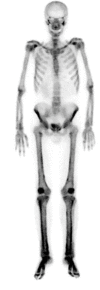Hypertrophic osteoarthropathy in renal cell carcinoma - A case report
- PMID: 34233412
- PMCID: PMC8342818
- DOI: 10.17085/apm.20092
Hypertrophic osteoarthropathy in renal cell carcinoma - A case report
Abstract
Background: Hypertrophic osteoarthropathy (HOA) is a rare clinical condition including an abnormal periosteal reaction in the long bones that causes painful swelling and tenderness of the extremities, digital clubbing, arthritis, synovitis, and joint effusions. Most cases are associated with tumorous conditions and most commonly with lung cancer. HOA has been rarely reported in association with other cancers.
Case: A patient with a history of recurrent renal cell carcinoma was referred to our clinic with bilateral leg pain, knee joint effusion, and arthritis. Simple radiography and bone scintigraphy confirmed a diagnosis of HOA. Oral non-steroidal anti-inflammatory drugs, joint fluid aspiration, and intra-articular injection of pain medications were found to be effective in the management of HOA pain.
Conclusions: HOA prognosis depends on the underlying disease, therefore, cancer treatment is critical. This case demonstrates the need to consider HOA in patients with various malignancies who present with bone or joint pain of the extremities.
Keywords: Paraneoplastic syndrome; Periostosis; Renal cell carcinoma; Scintigraphy; Secondary hypertrophic osteoarthropathy.
Conflict of interest statement
No potential conflict of interest relevant to this article was reported.
Figures



References
-
- Pineda C, Martínez-Lavín M. Hypertrophic osteoarthropathy: what a rheumatologist should know about this uncommon condition. Rheum Dis Clin North Am. 2013;39:383–400. - PubMed
-
- Diren HB, Kutluk MT, Karabent A, Göçmen A, Adalioğlu G, Kenanoğlu A. Primary hypertrophic osteoarthropathy. Pediatr Radiol. 1986;16:231–4. - PubMed
-
- Yap FY, Skalski MR, Patel DB, Schein AJ, White EA, Tomasian A, et al. Hypertrophic osteoarthropathy: clinical and imaging features. Radiographics. 2017;37:157–95. - PubMed
-
- Izumi M, Takayama K, Yabuuchi H, Abe K, Nakanishi Y. Incidence of hypertrophic pulmonary osteoarthropathy associated with primary lung cancer. Respirology. 2010;15:809–12. - PubMed
Publication types
LinkOut - more resources
Full Text Sources

